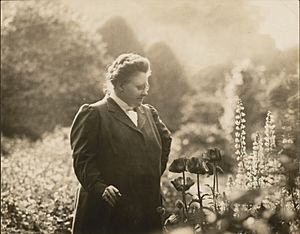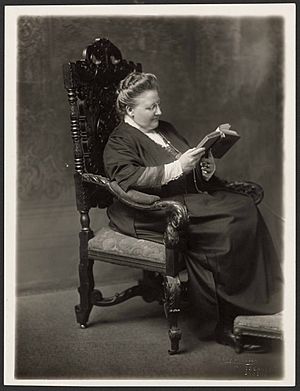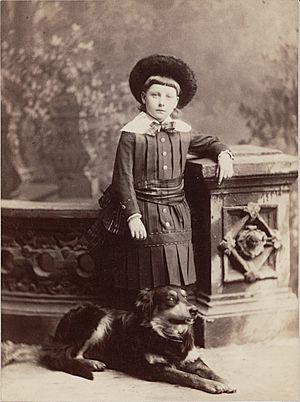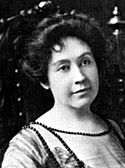Amy Lowell facts for kids
Quick facts for kids
Amy Lowell
|
|
|---|---|

Lowell at Sevenels, circa 1916
|
|
| Born | Amy Lawrence Lowell February 9, 1874 Brookline, Massachusetts, US |
| Died | May 12, 1925 (aged 51) Brookline, Massachusetts, US |
| Occupation | Poet |
| Notable awards | Pulitzer Prize for Poetry |
| Partner | Ada Dwyer Russell (together 1912–1925) |
Amy Lawrence Lowell (born February 9, 1874 – died May 12, 1925) was an American poet. She was part of the imagist movement, which focused on clear, sharp images in poetry. After she passed away, she won the famous Pulitzer Prize for Poetry in 1926.
Contents
Life Story of Amy Lowell
Amy Lowell was born in Boston, Massachusetts, on February 9, 1874. Her parents were Augustus and Katherine Bigelow Lowell. She came from a well-known family in Boston. Her siblings included the astronomer Percival Lowell and the educator Abbott Lawrence Lowell.
School was a difficult time for young Amy. She felt like an outsider and was known for speaking her mind.
Amy did not go to college because her family believed it wasn't proper for women at that time. Instead, she read a lot of books and collected them. She also traveled widely. She started writing poetry in 1902, when she was 28, after being inspired by a performance she saw in Europe.
In 1912, Amy Lowell became partners with actress Ada Dwyer Russell. The two women traveled to England together. There, Lowell met Ezra Pound, another important poet. Pound had strong opinions about Lowell's poetry and her involvement in the Imagist movement.

Amy Lowell was a small but strong-looking person. She often wore her hair in a bun and used a special type of glasses called a pince-nez. She was also known for publicly smoking cigars, which was unusual for women at the time. A health issue caused her to be overweight. Some people made fun of her, calling her a "hippopoetess," but her friends defended her. The writer Heywood Broun once wrote that even though she seemed like a typical New Englander on the outside, inside she was full of strong emotions.
Amy Lowell died in 1925, at age 51, from a brain hemorrhage. She is buried in Mount Auburn Cemetery. The year after she died, she won the Pulitzer Prize for Poetry for her book What's O'Clock. This collection included a poem called "Lilacs," which was a favorite of many.
Her first published poem appeared in Atlantic Monthly in 1910. Her first book of poems, A Dome of Many-Coloured Glass, came out in 1912.
Amy Lowell often wrote in "free verse," a style of poetry that doesn't follow strict rules of rhythm or rhyme. She explained that free verse is based on how people naturally speak, rather than a fixed beat. She also used a style called "polyphonic prose," where poems look like paragraphs of writing on the page, without line breaks.
Lowell was a big supporter of other poets, both new and old. She wrote a book called Fir-Flower Poets, which was her own version of old Chinese poems. She also wrote about French literature. When she died, she was working on a two-volume biography of the famous poet John Keats.
She not only published her own work but also helped other writers. She became a leader of the Imagist movement, which some people, like Ezra Pound, didn't like. Pound even jokingly called the American Imagists the "Amygists" because of her influence.
Amy Lowell wrote at least two poems about libraries: "The Boston Athenaeum" and "The Congressional Library."
Ada Dwyer Russell: An Inspiration
Ada Dwyer Russell was Amy Lowell's partner and inspired many of Lowell's romantic poems. Lowell wanted to dedicate her books to Russell, but Russell usually preferred to keep their private life out of the public eye. She only agreed once, for Lowell's biography of John Keats.
Some of Lowell's poems inspired by Russell include The Taxi, Absence, A Lady In a Garden, Madonna of the Evening Flowers, Opal, and Aubade. Lowell herself said that Russell was the subject of her series of romantic poems called "Two Speak Together." Many of the private letters between them were destroyed at Lowell's request, so we don't know all the details of their life together.
Legacy and Influence
After World War I, Amy Lowell's work was largely forgotten for a while. However, the women's movement in the 1970s helped bring her poetry back into the spotlight.
People today are also interested in Lowell's work for several reasons:
- Her poem "Patterns" is often taught because of its anti-war message.
- She used personification, giving human qualities to objects, in poems like "The Green Bowl" and "The Red Lacquer Music Stand."
- Her poems about Ada Dwyer Russell and her poem "The Sisters" (which talks about female poets before her) are also studied.
Lowell's letters with her friend Florence Ayscough, who translated Chinese literature, were published after her death.
Works
Books
- ''Selected Poems of Amy Lowell'', ed. Melissa Bradshaw and Adrienne Munich, New Brunswick, NJ: Rutgers University Press, 2002.
- The Complete Poetical Works of Amy Lowell, (The Riverside Press, Cambridge), 1955.
Choral settings of poetry
- To a Friend, by Giselle Wyers. Santa Barbara Music Publishing, Inc.
- Sea Shell, by Vicente Chavarria. Santa Barbara Music Publishing, Inc.
- This Perfect Beauty, by Jenni Brandon. Santa Barbara Music Publishing, Inc.
- A Winter Ride, by Misty L. Dupuis. Earth Cadence Publishing.
- The Giver of Stars, by Jenni Brandon. Jenni Brandon Music.
- A Dome of Many-Coloured Glass, by Dominick DiOrio. Hal Leonard.
- A Sprig of Rosemary, by Jeffrey Van. Hal Leonard.
- Absence, by Dominick DiOrio. G. Schirmer.
- At Night, by Jenni Brandon. Jenni Brandon Music.
- You Are the Music, by Victor C. Johnson. Chorister's Guild.
- The Giver of Stars, by Joan Szymko. Independent Music Publishers Cooperative.
- You Are the Music, by Joan Szymko. Independent Music Publishers Cooperative.
See also
 In Spanish: Amy Lowell para niños
In Spanish: Amy Lowell para niños
- Amy Lowell Poetry Travelling Scholarship




